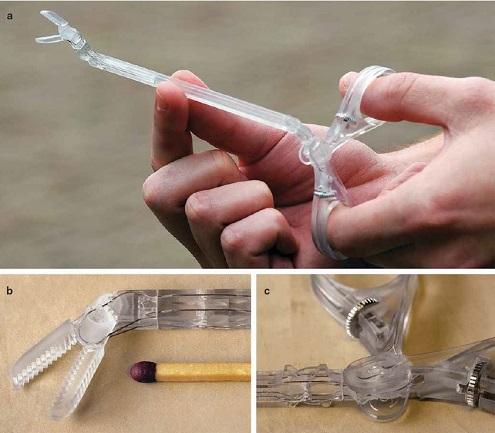Biomechanical engineer Filip Jelínek of the Austrian Center for Medical Innovation and Technology has developed prototypes for a medical device which use 3D design and printing which is likely to change how doctors analyze and remove cancerous tissues and perform what are known as “keyhole” operations.
 The tool is meant to be minimally invasive, and it’s aimed at improving the durability and manufacturability of medical instrumentation.
The tool is meant to be minimally invasive, and it’s aimed at improving the durability and manufacturability of medical instrumentation.
Working in collaboration with Paul Breedveld and Rob Pessers of Delft University of Technology, Jelínek built the DragonFlex, a steerable, minimally invasive surgical instrument prototype. It looks a bit like a pair of scissors, but procedures undertaken using the device cut recovery time for patients and leave less post-operative scar tissue behind.
Almost entirely 3D printed, the DragonFlex uses very few components to keep down manufacturing costs and limit assembly time. Jelínek believes the instrument can be marketed as a disposable, single-use product.
At just 5mm wide, the DragonFlex prototype features a rolling joint with a special driving cable guide and a simple bolt-and-wheel mechanism for cable clamping and adjusting tension. The DragonFlex was made via additive manufactured from a ceramic-filled epoxy resin.
According to Jelínek, while the DragonFlex provides nearly equivalent functionality to other steerable laparoscopic instruments, constructing it with 3D printing techniques provides a number of advantages.
“Using 3D printing changes the way TU Delft researchers design,” he says.
Only the cables and turnbuckles are made of metal.
The DragonFlex instrument tip contains just a few parts, and it’s driven and bound by two cables mechanically fixed in the handle. Two ‘orthogonal planar joints’ feature an innovative rolling link mechanism to let the cables to follow circular arc profiles of a diameter which is 1.5 times larger than the width of the instrument shaft.
 Aside from maximizing the lifespan of the cable, the rolling link was built to equalize the force requirements on both cables throughout the rotation of the joint. It makes handling fluid and effortless, and it also enables control of seven degrees of freedom.
Aside from maximizing the lifespan of the cable, the rolling link was built to equalize the force requirements on both cables throughout the rotation of the joint. It makes handling fluid and effortless, and it also enables control of seven degrees of freedom.
Two DragonFlex prototypes were developed using additive manufacturing technology, and they both allow grasping and omnidirectional steering over ±90° and feature high bending stiffness and extreme simplicity.
The orange prototype was printed by TNO (Eindhoven, The Netherlands) using a Perfactory® SXGA+ Mini Multi Lens rapid prototype manufacturing system from a ceramic‐filled epoxy resin, EnvisionTEC® NanoCure RCP 30, printed at 30μm resolution and 50μm layer thickness; the clear prototype was printed by PROFORM AG (Marly, Switzerland) using 3D Systems Viper si2™ SLA® System from 3D Systems Accura® 60, printed at 75±15μm resolution and 2.5μm layer thickness.
The DragonFlex is a medical instrument which aims to be an inexpensive replacement for existing tools. Do you know about any medical devices that have been improved with the aid of 3D printing? Let us know in the 3D Printed Medical Device for Complex Procedures forum thread on 3DPB.com.
[Source: ASME, Informa Healthcare]
Subscribe to Our Email Newsletter
Stay up-to-date on all the latest news from the 3D printing industry and receive information and offers from third party vendors.
You May Also Like
Further Understanding of 3D Printing Design at ADDITIV Design World
ADDITIV is back once again! This time, the virtual platform for additive manufacturing will be holding the first-ever edition of ADDITIV Design World on May 23rd from 9:00 AM –...
3D Printer Maker EVO-tech Reborn as NEVO3D — Once More With Feeling
EVO-tech was a 3D printing service and original equipment manufacturer established in 2013 and based in Schörfling am Attersee, Austria. The company produced high-quality material extrusion systems featuring linear bearings,...
3D Systems Brings 3D Printed PEEK Cranial Implant to the U.S. with FDA Clearance
For more than 10 years, 3D Systems (NYSE:DDD) has worked hand-in-hand with surgeons to plan over 150,000 patient-specific cases, and develop more than two million instruments and implants from its...
CDFAM Returns to Berlin for Second Annual Symposium
The second CDFAM Computational Design Symposium is scheduled for May 7-8, 2024, in Berlin, and will convene leading experts in computational design across all scales. Building upon the first event...

































